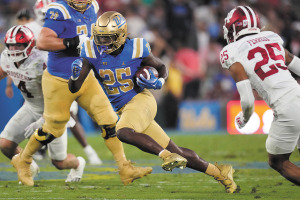Subscriber Benefit
As a subscriber you can listen to articles at work, in the car, or while you work out. Subscribe Now You have to be open-minded and adaptable to even comprehend the rate of change these days, much less embrace it. But the Big Ten Conference is testing the boundaries—of both acceptance and geography.
You have to be open-minded and adaptable to even comprehend the rate of change these days, much less embrace it. But the Big Ten Conference is testing the boundaries—of both acceptance and geography.
It now contains 18 teams from sea to shining sea, aka Newark to Seattle. If you’re wondering why a conference that calls itself the Big Ten doesn’t have 10 teams, don’t bother. Going along with the latest plan requires a shrug of the shoulders and total buy-in. Just roll with it. Forget logic, fairness, academics and arithmetic.
The only thing baby boomers and their like have left is nostalgia for the glory days.
It was a great thing, wasn’t it, before the focus shifted from competition and classrooms to the bottom-line business of adding major marketplaces for television networks? From 1950 to 1992, the Big Ten provided big-time entertainment in a concise, logical format. Nine huge, powerful institutions from Indiana, Ohio, Michigan, Illinois, Wisconsin, Minnesota and Iowa, along with the lovable nerd in the neighborhood, Northwestern.
The league ran narrow and deep in those days. The two members most distant from each other, Ohio State and Minnesota, were just 650 miles apart. Several teams lived within driving distance of one another. Just hop on a bus and go play. The tradition, history and highlights seemed endless. The accumulation of championships meant something. So did individual records. To be the conference’s all-time leader in this or that made one a legend.
The league had self-awareness, too. The name said it all. It was called the Big Ten in the early ’40s, the Big Nine in the late ’40s after the University of Chicago dropped out and then the Big Ten again when Michigan State joined in 1950.
And get this: It took academics into consideration. The term student-athlete did not inspire eye rolls. There was a time in the early ’70s when conference basketball games were played on Saturday and Monday. The idea was that the traveling team could leave after classes ended on Friday, play on Saturday, travel again to the next stop that evening or on Sunday and play again on Monday. The athletes missed just one day of classes.
That later was changed to a Thursday-Saturday format because there was some objection to athletes away from home on Sunday being unable to attend church. IU coach Bob Knight objected to that change because it meant two days of missed class time instead of one.
Each team had a travel partner to streamline the operation. Purdue was paired with Illinois, Indiana with Ohio State, Michigan with Michigan State, Northwestern with Wisconsin and Minnesota with Iowa. You played one of them on the first leg of the road trip and the other on the second.
Oh, and teams played each other twice, home and away. Only fair, right?
Today’s Big (not) Ten runs wide and shallow. Eighteen teams, as far as 2,800 miles apart. There are no travel partners. Games are played every day of the week. Starting times vary based on the whims of the television networks, and now you throw drastically different time zones into the mix. Members don’t play each other home and away. They play some teams twice, but others only on the road or only at home.
It’s not balanced, not fair, and it doesn’t seem as if a single concession has been made to academics.
And yet it probably will work out all right.
Coaches will adapt, as they have to the transfer portal and to the NIL chaos, players will like road trips to places they’ve never been, and fans will see plenty of great games. Admittedly, there were objections back in the day when the Big Ten added a 3-point shot, shot clock and postseason tournament. But life went on and nobody seems to mind now. You can’t fight the forces of evolution, especially when they are fueled by dollar signs.
A growing conference
The additions of Penn State in 1992, Nebraska in 2011, Maryland and Rutgers in 2012, and UCLA, USC, Oregon and Washington this year were made primarily with football and its revenue in mind, but the new format will have the most impact on basketball and other sports because of the length of the seasons and travel. Football teams have been traveling great distances for nonconference games forever. Purdue played at Oregon State just last Saturday. Now that all the major conferences throughout the country are playing musical chairs in an attempt to strengthen their footprint, adding teams is no longer a surprise. The Big Ten, however, broke the mold.
“I don’t think any of us were surprised by the expansion,” IU women’s basketball coach Teri Moren said. “What struck me was the teams we added. Playing in the Big Ten, being in the Midwest, this idea [that] we were going to bring West Coast schools into the conference caught me very, very much off guard, to say the least.”

But Moren acknowledged this fundamental fact: “Young people in particular get excited about anything that’s new.”
Purdue coach Matt Painter, who, like Moren, grew up in the Big Ten as a player at Purdue, says, “You kind of miss going to Ohio State and Michigan and Michigan State every year,” but he believes his players will look forward to new destinations. “They’re eager to compete more than anything. I think they’ll get excited once it happens.”
Painter’s team will visit Washington on Jan. 15 and Oregon on Jan. 18. To play those games, the players will miss four days of class. That doesn’t seem desirable but will be less of a factor in this era of online classes when entire classes can be taken remotely.
Besides, players aren’t likely to object to a road trip to Los Angeles for a few days in the winter months to play UCLA and USC. Troy Lewis, Purdue’s all-Big-Ten guard in 1987 and ’88, practically salivates at the thought of what it would have been like to go out to LA to play Reggie Miller’s UCLA teams.
“Oh, yeah. Oh, yeah. Oh, yeah,” Lewis said. “I would have loved it. Oh, yeah. That would have been sweet.”
And for fans, it means getting a closeup look at great players from the West normally seen only on late-night television because of the time-zone differences. The best and most intriguing women’s basketball player in the country this season is USC’s JuJu Watkins, who averaged 27.1 points and earned first-team, all-American honors as a freshman last season. Ohio State’s women already know her all too well. She scored 32 points in her college debut against the national-ranked Buckeyes last season. She’ll play at both IU and Purdue in the upcoming season.
Traveling teams
Besides, the schedules will be more challenging for the four new Western members. The 14 teams from the previous version of the conference have to make only one trip west for two games each season. Sounds like a nice vacation.
The four Western teams will be filling the skies all winter. UCLA, for example, plays at Nebraska on Jan. 4, Maryland on Jan. 10, Rutgers on Jan. 13, Illinois on Feb. 11, IU on Feb. 14, Purdue on Feb. 28 and Northwestern on March 3. And then it has to come back to Indianapolis for the Big Ten tournament March 12-16. Sounds like a lot of work.
Former UCLA guard Mike Warren, a South Bend native who played on national championship teams in 1967 and ’68, wonders how it will work out from the Western viewpoint.
He’s nostalgic for the days of playing in what was informally known as the Pac-8 Conference, when every team played each member home and away and rivalries blossomed, but he’s made a “bittersweet acceptance” of UCLA’s new conference home. The university’s athletic department was awash in red ink because of the lack of television revenue, and the Pac-12 was dissolving. It has just two members for the upcoming seasons, Oregon State and Washington State, with more on the way for future campaigns.
“It will be interesting to see if there are any casualties, grade-wise,” Warren said. “It’s called progress.”
This version of progress was not made for the primary benefit of the athletes, although it might have some. Warren recalled playing in the classic regular-season game against the University of Houston in the Astrodome on Jan. 20, 1968. Billed as the Game of the Century, it was the first nationally televised college basketball game and drew 52,693 fans. Each school was paid $125,000 for its participation.
“The players are always an afterthought,” said Warren, whose team lost 71-69 but avenged the defeat in the NCAA tournament on its way to another national championship. “When they decided to do the Astrodome game, they didn’t think about the players; it was about the revenue the game was going to bring and the number of eyes on it for television exposure.”
Sound familiar?
Warren looked up UCLA’s upcoming conference schedule while talking over the phone. “Man, what a schedule,” he said. “We’ve got to go to Purdue and Northwestern the same weekend, and Indiana and Illinois the same weekend. Wow. That’s a lot.”
Simply put, it’s as Painter said: “It’s more a corporation than a league when you have 18 teams.”
But that doesn’t mean it won’t be a good experience. All the revenue from television contracts has made for better facilities and travel arrangements for the players, and the fundamental nature of the experience hasn’t changed.
“Your experience is what you make of it,” Lewis said. “You’ve still got to compete. You’ve still got coaches yelling at you. You’ve still got to put in the work to be good.”
What happens to the corporation’s records book, though? Do the Big Ten championships won by Purdue and Indiana mean as much in the new alignment? What about individual records? Does Miller, who finished as UCLA’s second-all-time leading scorer, have a place in the Big Ten rankings? The lists are already filled with asterisks because some players were eligible for varsity competition as freshmen, and some were not. Get ready for more of them. But how many asterisks can the lists absorb before they are rendered meaningless?
So many questions. The answers will come, but no matter what they are, the games will go on. You’ll have to learn to like them. And you probably will.•
__________
Montieth, an Indianapolis native, is a longtime newspaper reporter and freelance writer. He is the author of three books: “Passion Play: Coach Gene Keady and the Purdue Boilermakers,” “Reborn: The Pacers and the Return of Pro Basketball to Indianapolis,” and “Extra Innings: My Life in Baseball,” with former Indianapolis Indians President Max Schumacher.
Please enable JavaScript to view this content.

As a boomer who attended IU from ’74 to ’78, I saw college ball at its best! I am dismade that money grubbing greed has transformed not just sports but pretty much everything! I agree we will adjust but society will not be the better for it.